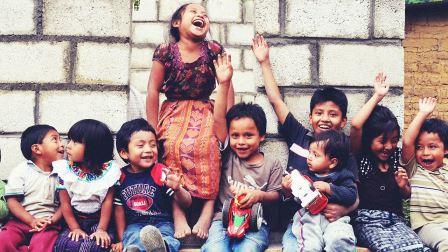Cheap Technology—And a Bit of Good Will—Are Bringing Hearing Aids To The World’s Poor
“It’s amazing what you can find in a kid’s ear…think bugs and cockroaches and little tiny kids with a tremendous amount of mold coming out of their ears.”
That’s Audra Renyi, executive director and cofounder of a 5-year-old Montreal-based nonprofit called “World Wide Hearing Foundation International” that wants to help the world’s other 99%: The hearing-impaired people in poor countries who can’t afford a hearing aid, debilitated by a condition that usually has a simple tech fix in wealthier societies.
“There are over half a billion people with hearing loss, and about half of that hearing loss is disabling,” says Renyi. The full extent of the problem was unknown until 2005, she says, when a volunteer group of audiologists and doctors collaborated with the UN’s World Health Organization on a global study. But the World Wide Hearing Foundation doesn’t just raise awareness: It puts boots on the ground with a program called “Hearing Express” that trains locals to test people’s hearing and provide radically discounted hearing aids.
The help is desperately needed in much of the world. Guatemala, for instance, is home to 15.5 million people, and yet the country has only one audiologist, Dr. Patricia Castellanos de Munoz. Honduras—population 8.1 million—has none, according to Renyi. Even if diagnosed by a professional, there’s not much a person with hearing loss can do in these countries: Hearing aids typically cost $2,000 to $3,000. Per-capita annual income in Honduras is just over $2,000, according to the U.N.
World Wide Hearing is tackling the problem first by putting locals—many of them women—through a five-week training program that allows them to do much of the work a professional audiologist would. “We’re always open to training men and women,” says Renyi. “If we’re able to train more women…it’s got that additional gender-empowerment piece.”
World Wide Hearing’s approach is a lower-tech counterpart to what an organization called “ORBIS International” provides for blindness. The latter has equipped a DC-10 airliner with operating rooms and classrooms where it can perform cataract surgery on patients in poor nations and train local doctors on the procedure. “I always see vision as kind of twenty years ahead of hearing in terms of how far they’ve come, in terms of raising money, awareness, the models they’ve piloted,” says Renyi.
Both organizations have the same goal: not only to help people immediately but to equip communities and countries to continue this work on their own. “We’re not looking to be necessarily in the countries for the next 20 years,” says Renyi.
Within a few days, World Wide Hearing trainees learn how to examine a patient and test their hearing with a backpack of low-cost equipment provided by the organization. In the remaining time, they learn how to fit and configure a hearing aid for the patients—providing a device that can help more than 90% of people with hearing loss, says Renyi. World Wide Hearing has simplified and economized the fitting process. High-end devices in affluent communities are custom-configured to the particular needs of each patient, requiring a computer and technical knowledge. World Wide hearing instead uses hearing aids that come with a selection of programs or profiles. The technician clicks through the programs to select the one that best matches the patient’s condition. “They’re not perfect,” says Renyi. “But we really think that some of these technologies have a big potential to really give more people access, especially if it simplifies the fitting process.”
Listening To The Market
The organization has also been able to cut tremendous deals with makers of hearing aids, driving the cost down from $2,000 to $3,000 to about $100-$150 each; it negotiates price cuts on testing equipment, too. Some of this is done out of the manufacturers’ goodwill, selling the devices at a discount—sometimes just above cost—to support the projects. Other companies slash their prices in order to get into new markets. “The developing world is probably the biggest growth area for anyone addressing hearing loss,” says Renyi. “The idea is you provide much higher volume, whether it’s hearing aids or equipment, at perhaps lower margins.”
The market approach extends to the patients: World Wide Hearing charges them based on what they can afford to pay, even if it’s very little. “We think [charging patients] is important because it generates revenue for the technicians we train,” says Renyi. “Also, it’s a way of ensuring that everyone values what they’ve received.”
World Wide Hearing’s embrace of business principles may come from the background of its cofounders. Claudio Bussandri was president and CEO of the health care services company McKesson Canada. He’s also been hearing impaired since childhood. Bussandri supports the organization in part through his family foundation. Renyi, a former investment banker with Miller Buckfire & Co. in New York City, left the job in 2007 to spend two years volunteering in Kenya, Rwanda, and Chad with organizations including Doctors Without Borders.
Along with helping to run World Wide Hearing, Renyi is about to launch a private venture called “Hearing Access World” that will sell low-cost hearing aids. The problem with the current system, says Renyi, isn’t the manufacturing cost of hearing aids, which including materials and labor range from about $100 to $400. It’s the high markups on low sales volume. “Hearing Access aims to change the business worldwide into a high volume, low margin business, starting with developing countries,” she says. “The goal is not to make oodles of money but to be sustainable and help millions of hearing-impaired.” Hearing Access World received backing from Grand Challenges Canada, which funds ventures to improve health in developing countries.
Global Expansion
As World Wide Hearing expands, it aims to drive equipment costs down by buying in bulk. Along with its predecessor volunteer group founded in 2001, World Wide Hearing has provided around 3,500 hearing aids. Its goal this year is to screen 30,000 children and provide 2,000 hearing aids, doubling those figures each successive year. The organization emphasizes children over adults, because they have the most to gain from getting early help that allows them to live normal lives. Last year, World Wide Hearing screened 5,000 people in Guatemala. In 2016 and 2017, it aims to screen 30,000 in Peru, 10,000 in Vietnam, an “a few thousand” in Canada’s arctic Nunavut territory, says Renyi.
The organization will also upgrade its technology with both connected mobile devices and a cloud database of hearing loss data, funded by a $550,000 grant from the Google Impact Challenge: Disabilities awards. Examining the ear for obstructions is the first step in the screening process. World Wide Hearing has the traditional otoscopes that doctors use to peer inside ears, but it’s also field-testing an iPhone attachment made by Cellscope called “Oto” that fits over the device’s camera. With the Cellscope, technicians will be able to snap a photo of an infected ear and send it to a doctor for diagnosis and instructions on how to deal with it. Someday, artificial intelligence systems may analyze these photos and make an automated diagnosis, without requiring a doctor, says Renyi .
The core piece of testing equipment is the audiometer—a device that sends out tones to a set of noise-canceling headphones. World Wide Hearing is using an app-based audiometer for iPads made by a company called Clearwater. Money from the Google.org grant is funding Clearwater to develop a cloud component for uploading results to a database. Combined with data from other organizations, World Wide Hearing aims to build an open-access global database of hearing loss. “It will enable the capture of that data and the aggregation of that data for the first time ever,” says Renyi.
That will allow organizations, governments, and businesses to know the extent of the hearing loss on a global scale, to find hotspots where there are high percentages of people with the problem, and to identify regions with too few specialists to treat them. Finding patients, and finding them soon, is critical. “On a day-to-day basis, what I get excited about is being able to help kids in particular,” says Renyi. “If you can help one child, even just one child, and connect them to the world, that’s what really makes a difference.”
Fast Company , Read Full Story
(28)




